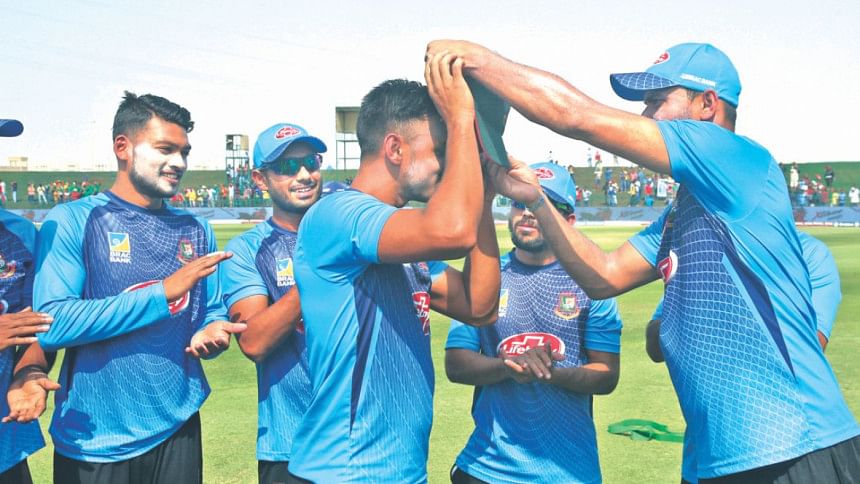Is the future of Bangladesh cricket actually in danger?

Bangladesh's young cricketers came under immense criticism in the recently concluded Asia Cup. It did not take too long for people to dismiss the likes of Nazmul Hossain Shanto, Liton Das and Mosaddek Hossain.
With none of them managing to perform in the initial stage of the tournament, there were talks about how weak the team would become in the near future following the departure of their senior most players—most of whom are expected to retire in the next four to five years.
However, how logical is the above assumption? Is it time to press the panic button already? The answer to these questions, of course, isn't straightforward. Yes, it is true that several players, aside from the five 'pillars' of the team, have come and gone in the last five years and very few of them have managed to secure a spot. However, one can't forget the fact that it took several years for the likes of Mushfiqur Rahim, Tamim Iqbal, and Shakib Al Hasan to reach the position that they are in today.
Mushfiqur, considered Bangladesh's most disciplined batsman, averaged just 19 in ODIs after his first three years. He, however, continued to be in the team because the selectors had faith in him. They believed that Mushfiqur's textbook batting approach would click one fine day. In the last six years, Mushiqur has been averaging above 44.
Mahmudullah Riyad has a similar story. He debuted in 2007 and in the next two years, had a batting average of just 25. He wasn't even considered as talented as the likes of Shakib, Tamim, or Mushfiqur. However, in the last four years he has averaged 42.
With the domestic structure a lot stronger than a decade ago, there are several more players in the fray. As a result, one could argue that it's a more difficult to give youngsters a chance for a prolonged period in the national team.
On the other hand, it is also true that some of the most talented players, many of whom are expected take the places of the Shakibs and Tamims in the near future, haven't managed to live up to their expectations, despite being given plenty of attention.
Take, for instance, the case of Sabbir Rahman. When he first entered the national team, he was easily the fittest player in the side. Selectors were so impressed with his potential, they replaced the in-form Nasir Hossain—who was back then dubbed the 'Finisher' for his ability to calmly take Bangladesh over the line from precarious positions—with Sabbir.

Sabbir hasn't been performing well in the recent past. Add to that, he is facing disciplinary issues and it will be an uphill battle for him to make it to the World Cup in England next year.
Shohag Gazi is another player who has failed to impress. When he debuted in 2012 against the West Indies in Tests, he was the first genuine off-spinner to break into the team since Fahim Muntasir in 2002. He couldn't have had a better entrance into international cricket. He removed Chris Gayle a number of times. Against New Zealand, he had become the first cricketer in the history of Tests to take a hat trick, a five-wicket haul, and score a century in the same Test. He too, however, faced disciplinary issues and his relationship with the Bangladesh Cricket Board deteriorated over time.
The young and fierce Taskin Ahmed is another example. In the case of Taskin, his injuries and lack of form have prevented him from sealing a spot in the national team.
A poor selection policy also prevented a number of players from becoming dependable batsmen and finding a permanent position in the team. The cases of Mominul Haque and Imrul Kayes are typical examples. Both the batsmen batted at positions which Bangladesh haven't been able to permanently fill since 2012. Till date, in terms of numbers, Imrul is still Tamim's most reliable partner at the top. In the last five years, Bangladesh has failed to produce an opening pair which has scored more than 1,000 runs. Imrul and Tamim have a partnership average of 49 in the last five years, easily the highest, and yet, he still needs 'special calls' to make it to the team.
Mominul bats at three, a position that has remained vacant ever since Habibul Bashar resigned. The few ODIs that the left-hander played showed immense promise. However, Chandika Hathurusingha's arrival led to Mominul's exclusion from the ODIs soon after the 2015 World Cup. He wasn't considered 'ODI material.' The sudden exclusion hurt Mominul in Tests as well since Bangladesh played more of T20s and ODIs back then, which hurt the left-hander's confidence.
It's too early to say whether Bangladesh will be helpless following the departure of their senior players. However, it won't be absolutely wrong to state that the Tigers haven't managed to maximise the potential of its players. And merely blaming the younger players and putting more pressure on them is likely to make the situation a lot worse.





Comments